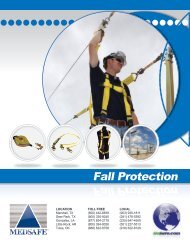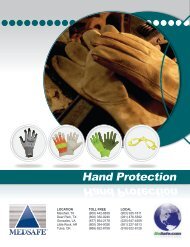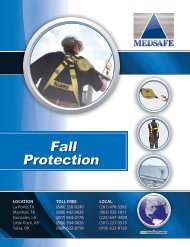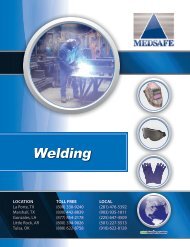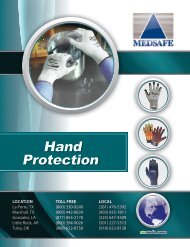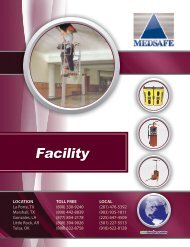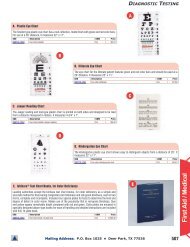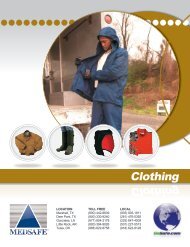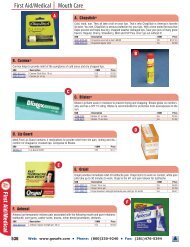Lockout Tagout - Gosafe.com
Lockout Tagout - Gosafe.com
Lockout Tagout - Gosafe.com
You also want an ePaper? Increase the reach of your titles
YUMPU automatically turns print PDFs into web optimized ePapers that Google loves.
<strong>Lockout</strong> / <strong>Tagout</strong><br />
<strong>Lockout</strong> / <strong>Tagout</strong><br />
Applying <strong>Lockout</strong>/<strong>Tagout</strong><br />
• Energy isolation and LOCKOUT/<br />
TAGOUT are to be applied only by<br />
trained employees authorized to perform<br />
service or maintenance.<br />
• Before LOCKOUT/TAGOUT is applied,<br />
all employees who work in the affected<br />
area must be notified.<br />
• OSHA requires that control of hazardous<br />
energy be done according to a<br />
six-step procedure.<br />
1) Preparation for Shutdown<br />
Before you turn off any equipment in order<br />
to lock or tag it out, you must know:<br />
• The types and amounts of energy that<br />
power it.<br />
• The hazards of that energy.<br />
• How the energy can be controlled.<br />
2) Equipment Shutdown<br />
• Shut the system down by using its<br />
operating controls.<br />
• Follow whatever procedure is applicable<br />
for the equipment, so that<br />
you don’t endanger anyone during<br />
shutdown.<br />
3) Equipment Isolation<br />
• Install all energy-isolating devices so<br />
that the equipment is isolated from its<br />
energy sources.<br />
• Be sure to isolate all energy sources<br />
and secondary power supplies as<br />
well as the main one.<br />
• Never pull an electrical switch while it<br />
is under load.<br />
• Never remove a fuse instead of disconnecting<br />
the energy or power.<br />
428<br />
Information<br />
4) Application of <strong>Lockout</strong>/ <strong>Tagout</strong><br />
Devices<br />
• All energy-isolating devices are to be<br />
locked, tagged or both according to<br />
your <strong>com</strong>pany LOCKOUT/TAGOUT<br />
procedures.<br />
• Only the standardized devices supplied<br />
by your employer are to be used<br />
for LOCKOUT / TAGOUT, and they are<br />
not to be used for anything else.<br />
• Use a LOCKOUT device if your lock<br />
cannot be placed directly on the<br />
energy control.<br />
• When LOCKOUT is used, every employee<br />
can lock out a single energyisolating<br />
device by using a multiplelock<br />
hasp.<br />
• For big jobs, a LOCKOUT box can be<br />
used to maintain control over a large<br />
number of padlocks and keys.<br />
• If tags are being used instead of<br />
locks, attach them at the same point<br />
as you would a lock, or as close to it<br />
as possible.<br />
• Fill tags out <strong>com</strong>pletely and correctly.<br />
5) Control of Stored Energy<br />
Take any of the following steps that are<br />
necessary to guard against energy left in<br />
the equipment after it has been isolated<br />
from its energy sources.<br />
• Inspect the system to make sure all<br />
parts have stopped moving.<br />
• Install ground wires.<br />
• Relieve trapped pressure.<br />
• Release the tension on springs, or<br />
block the movement of spring-driven<br />
parts.<br />
Performing The Work<br />
• Look ahead,and avoid doing anything<br />
that could re-activate the<br />
equipment.<br />
• Don’t bypass the lockout when putting<br />
in new piping or wiring.<br />
• Block or brace parts that could fall<br />
because of gravity.<br />
• Block parts in hydraulic and pneumatic<br />
systems that could move from<br />
the loss of pressure.<br />
• Bleed the lines and leave vent valves<br />
open.<br />
• Drain process piping systems and<br />
close valves to prevent the flow of<br />
hazardous materials.<br />
• If a line must be blocked where there<br />
is no valve, use a blank flange.<br />
• Purge reactor tanks and process<br />
lines.<br />
• Dissipate extreme cold or heat, or<br />
wear protective clothing.<br />
• If stored energy can<br />
reaccumulate,monitor it to make sure<br />
it stays below hazardous levels.<br />
6) Equipment-Isolation Verification<br />
Take any of the following steps that fit<br />
your <strong>com</strong>pany’s equipment and energy<br />
control program.<br />
• Make sure all danger areas are clear<br />
of personnel.<br />
• Verify that the main disconnect switch<br />
or circuit breaker can’t be moved to<br />
the “on”position.<br />
• Use a voltmeter or other equipment to<br />
check the switch.<br />
• Press all start buttons and other<br />
activating controls on the equipment<br />
itself to ensure that it is isolated.<br />
• Shut off all machine controls when<br />
the testing is finished.<br />
Warning<br />
These procedures alone do not give<br />
you all the tools you need to work<br />
safely around hazardous machines<br />
and energy sources. Your employer<br />
must have a written procedure and<br />
you must be trained in the use of<br />
LOCKOUT/TAGOUT devices. It is up to<br />
you to guard all workers and your own<br />
life and health by <strong>com</strong>plying with these<br />
rules.<br />
Web: www.gosafe.<strong>com</strong> • Phone: (800)330-9240 • Fax: (281)476-5394



